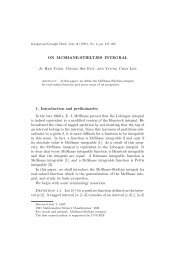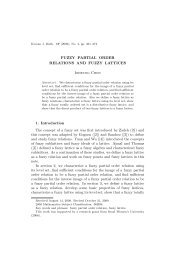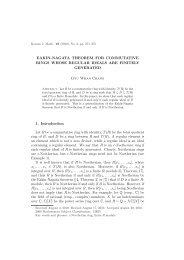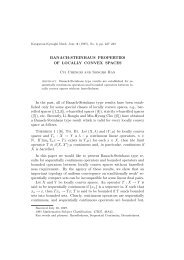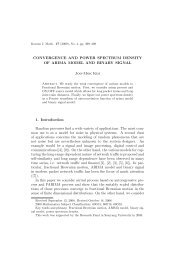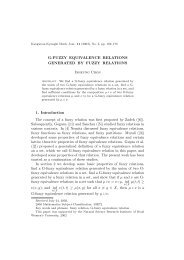THE WEAKLY SEMI-PRIME IDEALS OF po-Î-SEMIGROUPS ...
THE WEAKLY SEMI-PRIME IDEALS OF po-Î-SEMIGROUPS ...
THE WEAKLY SEMI-PRIME IDEALS OF po-Î-SEMIGROUPS ...
Create successful ePaper yourself
Turn your PDF publications into a flip-book with our unique Google optimized e-Paper software.
Kangweon-Kyungki Math. Jour. 5 (1997), No. 2, pp. 135–139<br />
<strong>THE</strong> <strong>WEAKLY</strong> <strong>SEMI</strong>-<strong>PRIME</strong><br />
<strong>IDEALS</strong> <strong>OF</strong> <strong>po</strong>-Γ-<strong>SEMI</strong>GROUPS<br />
*Young In Kwon and **Sang Keun Lee<br />
Abstract. We introduce the concepts of weakly prime and weakly<br />
semi-prime ideals in <strong>po</strong>-Γ-semigroup and give some characterizations<br />
of weakly prime and weakly semi-prime ideals of <strong>po</strong>-Γ-semigroups<br />
analogous to the characterizations of weakly prime and weakly semiprime<br />
ideals of <strong>po</strong>-semigroups considered by N. Kehayopulu.<br />
M. K. Sen([2]) have introduced Γ-semigroups in 1981. M. K. Sen<br />
and N. K. Saha([3]) have introduced Γ-semigroups different from the<br />
first definition of Γ-semigroups in the sense of Sen(1981). From Sen([2])<br />
we recall the following definition of Γ-semigroup.<br />
Let M and Γ be any two non-empty sets. M is called a Γ-semigroup<br />
if<br />
(1) MΓM ⊆ M, ΓMΓ ⊆ Γ.<br />
(2) (axb)yc = a(xby)c = ax(byc)<br />
for all a, b, c ∈ M and x, y ∈ Γ.<br />
In 1996, authors([5]) have introduced <strong>po</strong>-Γ-semigroups(: partially<br />
ordered Γ-semigroups).<br />
A <strong>po</strong>-Γ-semigroup is an ordered set M at the same time a Γ-semigroup<br />
such that:<br />
a ≤ b =⇒ aγx ≤ bγx and xµa ≤ xµb<br />
∀a, b, x ∈ M and ∀γ, µ ∈ Γ.<br />
In 1990, Kehayopulu([1]) obtained the four equivalent conditions to<br />
be weakly semiprime for an ideal T of a <strong>po</strong>-semigroup S.<br />
Received May 30, 1997.<br />
1991 Mathematics Subject Classification: 03G25, 06F35.<br />
Key words and phrases: <strong>po</strong>-Γ-semigroup, weakly prime, weakly prime ideal,<br />
weakly semi-prime, weakly semi-prime ideal.<br />
The second author was sup<strong>po</strong>rted in part by the Basic Science Research Institute<br />
Program, Ministry of Education, Korea, 1966, Project No. BSRI-96-1411.
136 Young In Kwon and Sang Keun Lee<br />
Theorem. An ideal T of a <strong>po</strong>-semigroup S is weakly semiprime if<br />
and only if one of the following four equivalent conditions hold in S:<br />
(1) For every a ∈ S such that (aSa] ⊆ T, we have a ∈ T.<br />
(2) For every a ∈ S such that (I(a)) 2 ⊆ T, we have a ∈ T.<br />
(3) For every right ideal A of S such that A 2 ⊆ T, we have A ⊆ T.<br />
(4) For every left ideal B of S such that B 2 ⊆ T, we have B ⊆ T.<br />
In this paper we obtain the similar results in <strong>po</strong>-Γ-semigroup and<br />
give the characterization of weakly prime ideals in <strong>po</strong>-Γ-semigroups.<br />
Now we recall the definitions and notations.<br />
Notation 1. For subsets A, B of M, let<br />
AΓB := {aγb|a ∈ A, b ∈ B and γ ∈ Γ}.<br />
Definition 1. Let M be a <strong>po</strong>-Γ-semigroup and A a nonempty subset<br />
of M. A is called a right(resp. left) ideal of M if<br />
(1) AΓM ⊆ A(resp. MΓA ⊆ A).<br />
(2) a ∈ A, b ≤ a for b ∈ M =⇒ b ∈ A.<br />
A subset A of M is called an ideal of M if it is a right and left ideal<br />
of M.<br />
See to [4] for the definitions of the left(right) ideals and ideals in<br />
Γ-semigroups.<br />
Notation 2[1]. For H ⊆ M, we denote<br />
(H] = {a ∈ M : a ≤ h for some h ∈ H}.<br />
We write (a] instead of ({a}](a ∈ M). We denote by I(a)(resp. R(a),<br />
L(a)) the ideal(resp. right ideal, left ideal) of M generated by a(a ∈<br />
M), respectively.<br />
We can easily prove that:<br />
for all a ∈ M.<br />
I(a) = (a ∪ MΓa ∪ aΓM ∪ MΓaΓM],<br />
R(a) = (a ∪ aΓM], L(a) = (a ∪ MΓa]
The weakly semi-prime ideals of <strong>po</strong>-Γ-semigroups 137<br />
Definition 2. Let M be a <strong>po</strong>-Γ-semigroup and T a nonempty subset<br />
of M. T is called weakly prime if for all ideals A, B of M such that<br />
AΓB ⊆ T, then A ⊆ T or B ⊆ T. T is called a weakly prime ideal if<br />
T is an ideal which is weakly prime.<br />
We can easily prove the following lemma.<br />
Lemma 1. Let M be a <strong>po</strong>-Γ-semigroup. Then we have<br />
(1) A ⊆ (A] for any A ⊆ M.<br />
(2) (A] ⊆ (B] for A ⊆ B ⊆ M.<br />
(3) (A]Γ(B] ⊆ (AΓB] for all A, B ⊆ M.<br />
(4) ((A]] ⊆ (A] for all A ⊆ M.<br />
(5) For every left (right, two-sided) ideal T of M, (T ] = T.<br />
(6) If A and B are ideals of M, then (AΓB] and A ∪ B are also<br />
ideals of M.<br />
(7) For every a ∈ M, (MΓaΓM] is an ideal of M.<br />
In [5; Theorem 5], we gave characterizations of weakly prime ideal<br />
elements of <strong>po</strong>e-Γ-semigroups (<strong>po</strong>-Γ-semigroup with the greatest element<br />
e.<br />
Now we give characterizations of weakly prime ideals of <strong>po</strong>-Γ-semigroups(not<br />
necessarily having the greatest element e).<br />
Theorem 1. Let M be a <strong>po</strong>-Γ-semigroup and T an ideal of M.<br />
Then T is prime if and only if for a left ideal A and a right ideal B of<br />
M such that AΓB ⊆ T, we have A ⊆ T or B ⊆ T.<br />
Proof. =⇒: It is obvious.<br />
⇐=: Let A be a left ideal and B be a right ideal of M. Then by<br />
hy<strong>po</strong>thesis, aΓb ⊆ T for any a ∈ A and for any b ∈ B. Then<br />
L(a)ΓR(b) = (a ∪ MΓa]Γ(b ∪ bΓM]<br />
⊆ (aΓb ∪ aΓbΓM ∪ MΓaΓb ∪ MΓaΓbΓM]<br />
⊆ (T ∪ T ΓM ∪ MΓT ∪ MΓT ΓM]<br />
= (T ] = T<br />
By hy<strong>po</strong>thesis, a ∈ L(a) ⊆ T or b ∈ R(b) ⊆ T, and so A ⊆ T or B ⊆ T.<br />
Therefore T is weakly-prime. □ □
138 Young In Kwon and Sang Keun Lee<br />
Definition 3. Let M be a <strong>po</strong>-Γ-semigroup and T a subset of M.<br />
Then T is called weakly semi-prime if every ideal A of M such that<br />
AΓA ⊆ T, we have A ⊆ T.<br />
Theorem 2. Let M be a <strong>po</strong>-Γ-semigroup and T an ideal of M.<br />
Then the following are equivalent:<br />
(1) T is weakly semi-prime.<br />
(2) For every a ∈ M such that (aΓMΓa] ⊆ T, we have a ∈ T.<br />
(3) For every a ∈ M such that I(a)ΓI(a) ⊆ T, we have a ∈ T.<br />
(4) For every right ideal A of M such that AΓA ⊆ T, we have A ⊆ T.<br />
(5) For every left ideal A of M such that AΓA ⊆ T, we have A ⊆ T.<br />
Proof. (1) =⇒ (2). Let a ∈ M and (aΓMΓa] ⊆ T. Then we have<br />
(MΓaΓM]Γ(MΓaΓM] ⊆ (MΓaΓMΓMΓaΓM]<br />
⊆ (MΓ(aΓMΓa]ΓM]<br />
⊆ (MΓT ΓM]<br />
⊆ (T ] = T.<br />
Since (MΓaΓM] is an ideal of M and T is weakly semiprime, we have<br />
(MΓaΓM] ⊆ T. Then we get<br />
(I(a)ΓI(a)]Γ(I(a)ΓI(a)] ⊆ (T ] = T.<br />
Since T is weakly semiprime and (I(a)ΓI(a)] is an ideal of M, we<br />
have (I(a)ΓI(a)] ⊆ T, and so I(a)ΓI(a) ⊆ T. And since T is weakly<br />
semiprime and I(a) is an ideal of M, we have I(a) ⊆ T, and so a ∈ T.<br />
(2) =⇒ (3). Let a ∈ M and let I(a)ΓI(a) ⊆ T. Now<br />
(a]Γ(MΓa] ⊆ (I(a)ΓMΓa]<br />
⊆ (I(a)(ΓMΓ)I(a)]<br />
⊆ (I(a)ΓI(a)]<br />
⊆ (T ] = T.<br />
and so<br />
((a]Γ(MΓa]] ⊆ (T ] = T.
The weakly semi-prime ideals of <strong>po</strong>-Γ-semigroups 139<br />
Since (aΓMΓa] ⊆ ((a]Γ(MΓa]] ⊆ ((aΓMΓa]] ⊆ (aΓMΓa], we have<br />
(aΓMΓa] = ((a]Γ(MΓa]]. Therefore (aΓMΓa] ⊆ T. By (2), we get<br />
a ∈ T.<br />
(3) =⇒ (4). Let A be a right ideal of M such that AΓA ⊆ T and a<br />
any element of A. Then we have<br />
Thus we get<br />
I(a) = (a ∪ MΓa ∪ aΓM ∪ MΓaΓM]<br />
⊆ (A ∪ MΓA ∪ AΓM ∪ MΓAΓM]<br />
= (A ∪ MΓA].<br />
I(a)ΓI(a) ⊆ (A ∪ MΓA]Γ(A ∪ MΓA]<br />
⊆ ((A ∪ MΓA)Γ(A ∪ MΓA)]<br />
= (AΓA ∪ AΓMΓA ∪ MΓAΓA ∪ MΓAΓMΓA]<br />
⊆ (T ∪ MΓT ]<br />
= (T ] = T.<br />
By (3), a is contained in T. Therefore A ⊆ T.<br />
(3) =⇒ (5). The proof is similar to the one of (3) =⇒ (4).<br />
(4), (5) =⇒ (1). They are obvious. □ □<br />
References<br />
1. N. Kehayopulu, On weakly prime ideals of ordered semigroups, Math. Ja<strong>po</strong>n.<br />
35 (1990), 1051-1056.<br />
2. M. K. Sen, On Γ-semigroups, Proc. of the Int. Conf. on Algebra and it’s Appl.,<br />
Decker Publication, New York 301.<br />
3. M. K. Sen and N. K. Saha, On Γ-semigroup I, Bull. Cal. Math. Soc. 78 (1986),<br />
180-186.<br />
4. N. K. Saha, On Γ-semigroup II, Bull. Cal. Math. Soc. 79 (1987), 331-335.<br />
5. Y. I. Kwon and S. K. Lee, Some special elements in ordered Γ-semigroups,<br />
Kyung<strong>po</strong>ok Math. J. Vol 35 (1996), 679-685.<br />
Department of Mathematics<br />
College of Education<br />
Gyeongsang National University, Chinju 660-701, Korea<br />
E-mail: *yikwon@ nongae.gsnu.ac.kr, **sklee@ nongae.gsnu.ac.kr


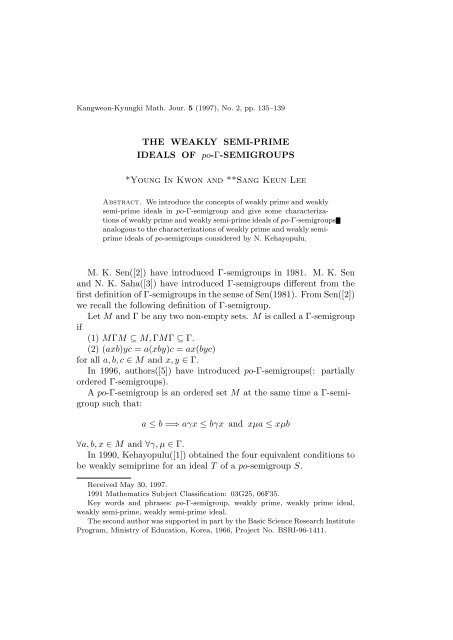
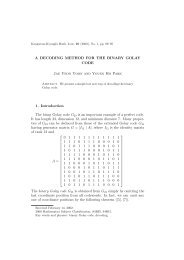
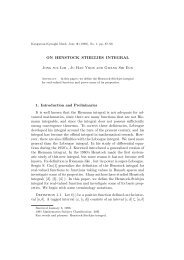
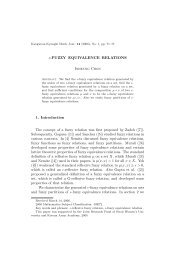
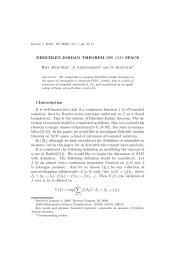

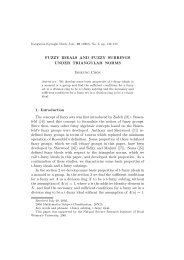
![SEMI-REGULAR po-SEMIGROUPS SK Lee J. Calais([1])](https://img.yumpu.com/46211509/1/184x260/semi-regular-po-semigroups-sk-lee-j-calais1.jpg?quality=85)
